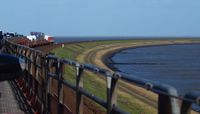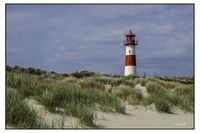Island of Sylt: Difference between revisions
| Line 131: | Line 131: | ||
== A.4 References == | == A.4 References == | ||
* '' | * ''https://de.wikipedia.org/wiki/Sylt'' | ||
= Phase B: Landscape Evaluation and Assessment = | = Phase B: Landscape Evaluation and Assessment = | ||
Revision as of 10:38, 14 April 2018
>>>back to working groups overview
| Area | Island of Sylt | |
| Place | Westerland | |
| Country | Germany | |
| Topics | tourism, nature protection | |
| Author(s) | Florian Matthies | |

| ||
Rationale
- Why do you think this case is relevant? What is your hypothesis considering the landscape challenges?
- The island of Sylt in Germany is a very important tourist destination and plays an essential role for the region's economy. However, Sylt is facing tremendous challenges considering the massive loss of land due to erosion and storm tides which endangerous its future for tourism. But also the tourism has strong negative impacts, like gentrification, which drives out the local population.
Location and scope
You can edit this map with the map editor
A Landscape System Analysis
A.1 Landscape layers and their system context
Geomorphology, landscape units and coastal typology
- Description of evolution, status quo and driving forces, is the coastal typology changing? Why is that? (approx 200 signs)
The coastal landscape of Sylt is characterized by long sandy beached and sand dunes. On the western side there is a 30 m high cliff coast, the 'red cliff'. To the east, the island is connected to tidal flats. Sylt was created by a moraine of the last ice age. The rock eroded in the course of a sea level rise 8000 years ago. Thereby the western edge was pushed more and more to the east, while the island extended to the north and south. Until 1362 Sylt could be reached overland during low tide. Then Sylt became a real island after a massive storm tide washed away a lot of sediment between Sylt and the mainland. During the last centuries the characteristic shape of the island is constantly subjected to changes, especially the northern and southern parts. Because of the tidal activity and strong sea currents these parts were sometimes larger or smaller, sometimes connected or disconnected to the rest of the island. A big problem is the permanent loss of land, especially caused by storm tides. In average the sea takes away one meter coast line per year. Due to the climate change and thereby increased storm tides, the threat to the island grows larger and larger.
Land use
- settlements, infrastructure, agriculture, resource extraction, natural areas, energy production...
- description of evolution, status quo and driving forces, is the land use likely to change? Why is that? (approx 200 signs)
The population of Sylt is around 17.700. Apart from the biggest town Westerland there are several smaller villages distributed on the island. Since 1927 Sylt is connected by a railroad on an artificial dam to the mainland. Regional and intercity trains are arriving and departing in Westerland. A road connection to the main land is not existing. Besides the train, there are several ferry connections to the mainland and the neighboring islands. The road net work on the island is well developed. Public transport on the island is available by several bus lines. The local train connection on the island was decommissioned in 1970. Today the former track serves as cycle connection from north to south and adds to the 250 km excellent cycle network of the island. Since the 70s agriculture plays a very subordinated role in the island's economy. Nowadays the economy is almost entirely related to tourism. Tourism started very early on Sylt. In 1855 Westerland was declared as sea resort and became very popular of its cures. In the 60s tourism developed rapidly and big hotels and apartment houses emerged. Sylt has very rich natural landscapes. Many places are protected. There are 10 nature protection areas and several landscape protection areas, FFH and Natura 2000 areas. A big impact on the land hast the real estate market. The huge demand of housing and lack of space cause the highest real estate prices in whole Germany. Gentrification is extremely high. The local population is no longer able to cope with exploding living expenses and the island's settlements are under the threat to became holiday towns only.
Green/blue infrastructure
- What are the major potential elements of a green/blue infrastructure network? Are these likely to change/disappear? Why is that?
The most dominant green/blue infrastructure at Sylt's biggest settlement Westerland can be found along the coast line. A continous corridor of sandy beach and dunes forms a north-south connection at the western side of the town. Pathways are leading through this landscape. Thereby nature can be experienced by the residents. It is unlikely that this important green/blue infrastructure will disappear in cause of building activity. Although there is an extreme pressure on land and housing, this area is strictly protected by nature reserves. The risk of loosing this area is displayed by nature itself. Tides and storms permanently wash away the land and push the coast line towards the settlement.
Actors and stakeholders
- Who is driving changes in this landscape? Who is affected by those changes?
- Draw a stakeholder and/or power map: Who is affected highly but with low power? Who has high power but is not affected?
Sacred spaces and heritage
- Which places/elements hold cultural value and to whom?
- You may add a map and some images, please also explain in your caption why these elements are valuable
Sylt has to offer various sacred places and cultural heritage. Very characteristic for the island's villages is the 'Friesenhaus', the traditional house with the typical roof made of reeds. However these houses became rare due to the big pressure on housing. People already settled on Sylt since the Stone Age. There are 47 megalith areas on Sylt. These are acient burial mounds. One of the most impressive one is 'Denghoog' near Wenningstedt. From the Iron Age some castles remained on Sylt. The best preserved one is 'Tinnumburg'. They were propably used as sanctuaries. Also World War 2 left its traces on the island. Various bunkers can be found along the coast, the most remarkable is 'Bunker Hill'. All these places are strongly connected to the island's rich history. Without them the unique identity of Sylt would be lost, which would be disastrous for both, tourists and the local population.
Visual appearance and landscape narrative
- Which elements are essential for the landscape character?
- Has the landscape been painted or otherwise depicted, when and whom? Which elements are essential?
- Which narratives exist? Who has written about this landscape or depicted it in some way?
The landscape on Sylt is mainly characterized by long sandy beaches with the typical dunes overgrown by grass. Very common along the beaches are so called 'Buhnen', erosion control measures. They are supposed to break the force of the incoming waves. Especially the old ones made of wood are very picturesque and have a strong influence on the appearance of the landscape. Also lighthouses are a very common and typical sight at the coast. All the while this landscape has attracted many painters and writers who were strongly inspired by the untamed and wild scenery. In most of the paintings the described landscape elements play an essential role, as well as in several books and writings. It seems that Sylt offers the perfect setting for novels, since there are numerous available.
A.2 Summary of you landscape system analysis and your development Targets
- You can summarize your findings with an DPSI(R) Model or a Spider Diagram
- Link back to the Sustainable Development Goals: Which goals are at risk?
- What is your hypothesis for this landscape?
- Visualise your hypothesis with one graphic/pict
- Are there any existing initiatives taking action in this landscape? Do you have a critical perspective on that?
- Add text and visuals
- Your case your spider diagram or dpsir model.jpg
explain your analysis briefly in the caption
- Your case your hypothesis visual.jpg
explain your hypthesis briefly in the caption
A.3 Theory reflection
- Reflect on at least three international policy documents in relation to their local landscape case
- choose one international, one European and one national document
- You can choose references from our reading list
- Scope: 250 words
A.4 References
Phase B: Landscape Evaluation and Assessment
B.1 Assessment Strategy
- Based on the hypothesis derived from your previous landscape systems analysis you are now asked to define the goals for assessing the landscape. Your assessment is the basis for evaluating the landscape status.
- Which elements and phenomena need to be mapped, why and how?
- This a text contribution, max 250 words
B.2 Mapping
- As defined by your assessment strategy you conduct the mapping and present your findings here
- As a minimum, at least three different themes need to be mapped, you may choose more if needed
- Your case your assessment mapping themel.jpg
briefly explain the findings of your mapping
- Your case your assessment mapping theme2.jpg
briefly explain the findings of your mapping
- Your case your assessment mapping theme3.jpg
briefly explain the findings of your mapping
B.3 Problem definition and priority setting
- Give a summary of the major findings of your mapping process, what are the problems/potentials identified?
- Draw a problems/potentials map
- Set priorities for the most relevant issues
- Your case problems potentials map.jpg
add caption here
B.4 Theory reflection
- Please reflect the assessment and evaluation methods used based on at least three readings
- Did you encounter limitations'
- 200 words test contribution
B.5 References
- give a full list of the references you have used for this section
Phase C – Strategy and Master Plan
C.1 Goal Setting
- Define strategic planning objectives based on the evaluation findings
- Link back to your original targets from section one and the Development Goals
- 150 words text contribution
C.2 Spatial Strategy and Transect
- translate your strategic goals into a vision
- develop a spatial translation of your vision
- exemplify your vision in the form of a transect with concrete interventions
- add map(s) and visualizations
- Your case spatial translaton vision.jpg
add caption here
- Your case transect.jpg
add caption here
- Your case transect detail1.jpg
add caption here
- Your case transect detail2.jpg
add caption here
C.3 From Theory of Change to Implementation
- For implementing your vision: Which partnerships are needed? Which governance model is required?
- Who needs to act and how? Draw and explain a change/process model/timeline
- Which resources are needed? On which assets can you build?
- add 150 words text and visuals
- Your case spatial your governance model.jpg
add caption here
- Your case spatial your process model.jpg
add caption here
C.4 References
- give a full list of the references you have used for this section
D. Process Reflection
- Reflect in your intercultural and interdisciplinary team on the outcomes of your study
- Which limitations were you facing?
- What have you learnt from each other?
- What would you do differently next time?
- You can also use diagrams/visuals
- 250 words text














